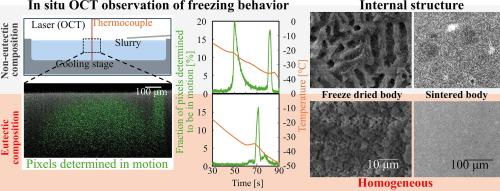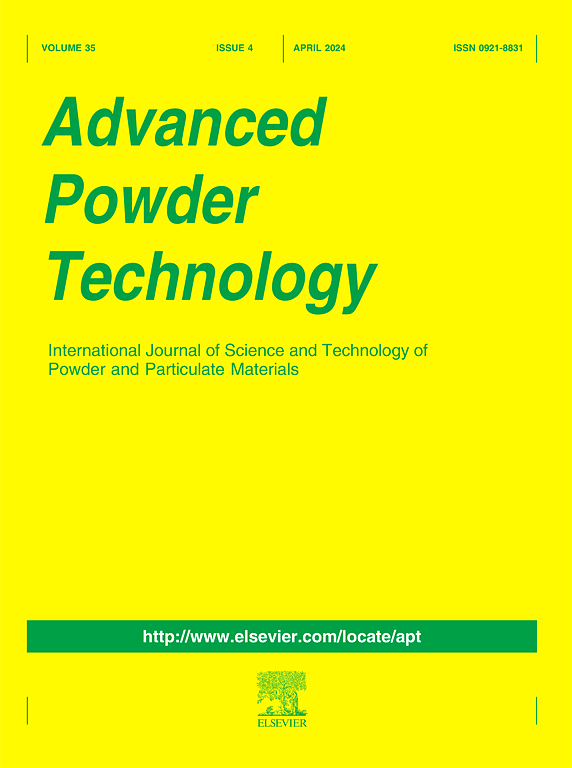叔丁醇和环己烷溶剂混合物制备的氮化硅浆料的冷冻性能和喷雾冷冻造粒干燥
IF 4.2
2区 工程技术
Q2 ENGINEERING, CHEMICAL
引用次数: 0
摘要
喷雾冷冻造粒干燥技术适用于获得柔软和均匀的颗粒,但使用水性浆料可能会降解氮化物等原料。本文研究了叔丁醇、环己烷及其溶剂混合物制备的氮化硅浆料的冷冻性能,并采用喷雾冷冻造粒干燥技术对浆料进行了颗粒制备。原位光学相干层析成像对冻结行为的观察表明,由共晶组成的溶剂混合物形成的浆液比其他溶剂混合物在更短的时间内一步冻结。共晶组分的溶剂混合物在冻干体中产生均匀的内部结构和细孔。喷雾冷冻造粒干燥制备的该组合物颗粒尺寸较小,粒径分布较窄,使氮化硅陶瓷内部结构均匀。本文章由计算机程序翻译,如有差异,请以英文原文为准。

Freezing behaviour and spray freeze granulation drying of silicon nitride slurries prepared from tert-butyl alcohol and cyclohexane solvent mixtures
A spray freeze granulation drying technique is suitable for obtaining soft and homogeneous granules, but the use of an aqueous slurry could degrade raw materials such as nitride. In this study, the freezing behaviour of silicon nitride slurries prepared from tert-butyl alcohol, cyclohexane, and their solvent mixtures was investigated, and granules were obtained from these slurries by the spray freeze granulation drying technique. An in situ optical coherence tomography observation of the freezing behaviour showed that the slurry from a solvent mixture of the eutectic composition froze in a single step in a shorter time than the other solvent mixtures. The solvent mixture of the eutectic composition yielded a homogeneous internal structure with fine pores in the freeze-dried body. The granules of that composition prepared by spray freeze granulation drying had a smaller size and a narrower size distribution, which resulted in a homogeneous internal structure of silicon nitride ceramics.
求助全文
通过发布文献求助,成功后即可免费获取论文全文。
去求助
来源期刊

Advanced Powder Technology
工程技术-工程:化工
CiteScore
9.50
自引率
7.70%
发文量
424
审稿时长
55 days
期刊介绍:
The aim of Advanced Powder Technology is to meet the demand for an international journal that integrates all aspects of science and technology research on powder and particulate materials. The journal fulfills this purpose by publishing original research papers, rapid communications, reviews, and translated articles by prominent researchers worldwide.
The editorial work of Advanced Powder Technology, which was founded as the International Journal of the Society of Powder Technology, Japan, is now shared by distinguished board members, who operate in a unique framework designed to respond to the increasing global demand for articles on not only powder and particles, but also on various materials produced from them.
Advanced Powder Technology covers various areas, but a discussion of powder and particles is required in articles. Topics include: Production of powder and particulate materials in gases and liquids(nanoparticles, fine ceramics, pharmaceuticals, novel functional materials, etc.); Aerosol and colloidal processing; Powder and particle characterization; Dynamics and phenomena; Calculation and simulation (CFD, DEM, Monte Carlo method, population balance, etc.); Measurement and control of powder processes; Particle modification; Comminution; Powder handling and operations (storage, transport, granulation, separation, fluidization, etc.)
 求助内容:
求助内容: 应助结果提醒方式:
应助结果提醒方式:


